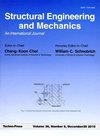Effect of stress-strain curve changing with equal channel angular pressing on ultimate strength of ship hull stiffened panels
IF 2.2
4区 工程技术
Q2 ENGINEERING, CIVIL
引用次数: 0
Abstract
Similar to other structures, ultimate strength values showing the maximum load that the structure can resist without damaging has great importance on ships. Therefore, increasing the ultimate strength values will be an important benefit for the structure. Low carbon steels used in ships due to their low cost and good weldability. Improving the ultimate strength values without interfering with the chemical composition to prevent of the weldability properties of these steels would be very beneficial for ships. Grain refinement via severe plastic deformation (SPD) is an essential strengthening mechanism without changing the chemical composition of metallic materials. Among SPD methods, equal channel angular pressing (ECAP) is one of the most commonly used one due to its capacity for achieving bulk ultrafine-grained (UFG) materials. When the literature is examined, it is seen that there is no study about ultimate strength calculation in ships after ECAP. Therefore, the mean purpose of this study is to apply ECAP to a shipbuilding low carbon steel to be able to achieve mechanical properties and investigate the alteration of ship hull girder grillage system's ultimate strength via finite element analysis approach. A fine-grained (FG) microstructure with a mean grain size of 6 um (initial grain size was 25 um) was after ECAP. This microstructural evolution brought about a considerable increase in strength values. Both yield and tensile strength values increased from 280 MPa and 425 MPa to about 420 MPa and 785 MPa, respectively. This improvement in the strength values reflected a finite element method to determine the ultimate strength of ship hull girder grillage system. As a result of calculations, it was reached significantly higher ultimate strength values (237,876 MPa) compared the non-processed situation (192,986 MPa) on ship hull girder grillage system.等径角压应力-应变曲线变化对船体加筋板极限强度的影响
与其他结构类似,极限强度值显示了结构在不损坏的情况下所能承受的最大载荷,这在船舶上非常重要。因此,提高结构的极限强度值将是一个重要的利益。低碳钢由于其低成本和良好的可焊性而被用于船舶。提高这些钢的极限强度值而不影响其化学成分以防止其可焊性,对船舶是非常有益的。剧烈塑性变形的晶粒细化是金属材料在不改变其化学成分的情况下的一种重要强化机制。在SPD方法中,等通道角压(ECAP)是最常用的一种方法,因为它能够获得大块超细晶(UFG)材料。在查阅文献时,没有关于ECAP后船舶极限强度计算的研究。因此,本研究的主要目的是将ECAP应用于船舶低碳钢,使其能够获得力学性能,并通过有限元分析方法研究船体梁-格栅系统极限强度的变化。经ECAP处理后,形成平均晶粒尺寸为6 um(初始晶粒尺寸为25 um)的细晶(FG)显微组织。这种微观结构的演变带来了强度值的显著提高。屈服强度和抗拉强度分别从280 MPa和425 MPa提高到约420 MPa和785 MPa。这种强度值的提高反映了用有限元法确定船体梁-格架系统极限强度的方法。计算结果表明,与未经处理的船体梁格架系统的极限强度(192,986 MPa)相比,其极限强度值(237,876 MPa)显著提高。
本文章由计算机程序翻译,如有差异,请以英文原文为准。
求助全文
约1分钟内获得全文
求助全文
来源期刊

Structural Engineering and Mechanics
工程技术-工程:机械
CiteScore
3.80
自引率
18.20%
发文量
0
审稿时长
11 months
期刊介绍:
The STRUCTURAL ENGINEERING AND MECHANICS, An International Journal, aims at: providing a major publication channel for structural engineering, wider distribution at more affordable subscription rates; faster reviewing and publication for manuscripts submitted; and a broad scope for wider participation.
The main subject of the Journal is structural engineering concerned with aspects of mechanics. Areas covered by the Journal include:
- Structural Mechanics
- Design of Civil, Building and Mechanical Structures
- Structural Optimization and Controls
- Structural Safety and Reliability
- New Structural Materials and Applications
- Effects of Wind, Earthquake and Wave Loadings on Structures
- Fluid-Structure and Soil-Structure Interactions
- AI Application and Expert Systems in Structural Engineering. Submission of papers from practicing engineers is particularly encouraged.
 求助内容:
求助内容: 应助结果提醒方式:
应助结果提醒方式:


